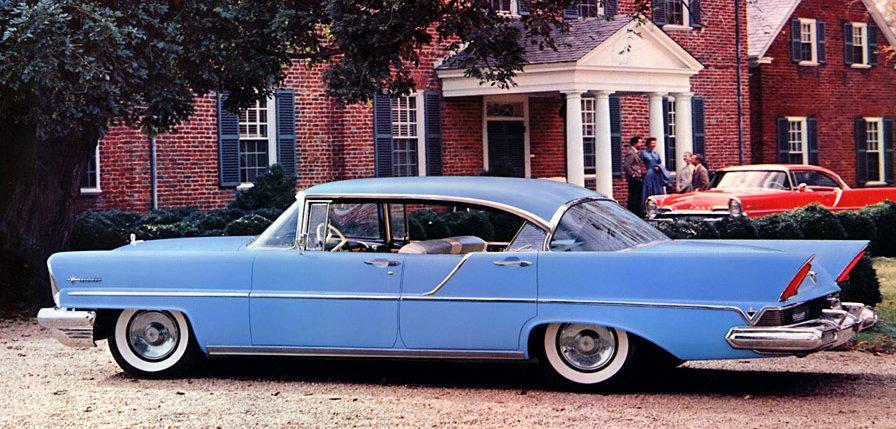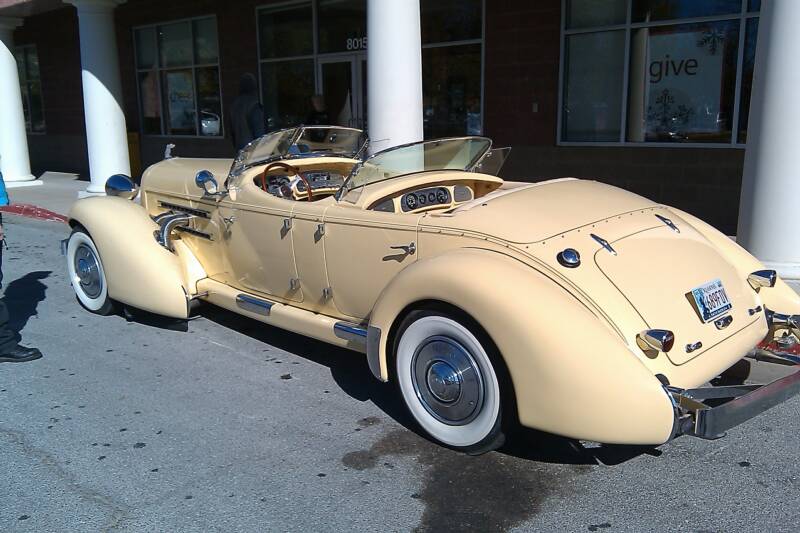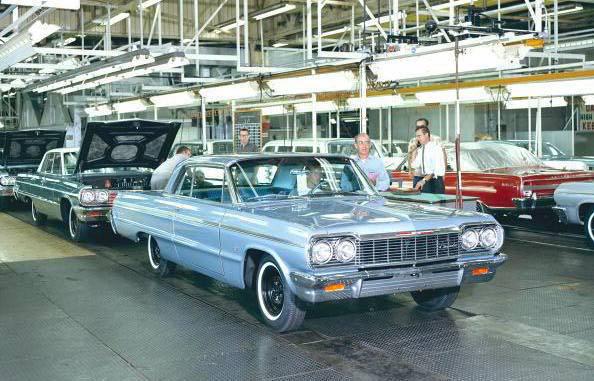Back When …
Which Era Are You From?
repair shop tell us about those simpler
times; the times when you could fix a
car with bailing wire and a boot strap.
Let’s take a look back at the way things
were, back to the time when the old salty
dog mechanic was just a green apprentice
in the shop, and see what it was really like.
Maybe you’ll find where you are, where you
come from, and where we’re all heading.
Pre-War and Post War Era
The Artisan Years
industry was of course World War II.
The 1940’s is by far the most unusual
time in automotive industry. This was the
only time production actually stopped. 1942
was the last civilian production year and
no new production was started back up
until 1946. Early 40’s cars were all about
luxury, and showcased the wealth and
status of its owner.
of pride to the craft of creating an automobile. Luxury, style, and pure craftsmanship were evident in almost all the models produced back then. A new car in the 1940’s would set you back about $800.00, and a full out luxury convertible by 1949. with all the bells and whistles could run a whopping $3,970.00 (Chrysler’s Town and Country Woody).
By the mid 40’s gas prices shot up to .18 cents a gallon. Average mileage back then for a production car… 15-20 mpg. Fluid drives, over drives, and power brakes were offered as standard features. Sealed headlights and heating systems were becoming standard features as well.
1950 – 1959
The Style and Chrome Era
The post war years brought on a prosperous time in America. Soldiers returned and settled with their young families in a new concept of housing… the suburbs. Farms were getting larger and smaller farms were being combined. Farm tractors and implements made huge advancements in their capabilities, which meant that fewer hands were needed on the farms. It was the time when more roads and bridges were being constructed, as well as full scale manufacturing of all types of goods was sweeping the nation. More returning GI’s searched out work in the big cities, and getting there required a car. By 1950 there were almost 40 million cars on the road, (40% increase from the 40’s) and 3 out of 5 families owned a car.
Car manufacturers were going for the glitz, glamor, and larger size of cars. Some models by the late 50’s reached epic proportions. Advertising was more likely to emphasize the cosmetics of the car rather than the mechanical features. New colors, chrome, automatic and power accessories overwhelmed a new car buyer. Tail fins started out small in the early 50’s, but by the end of the decade they were the size of small sails. These designs all grew out of the big fad of space travel, rockets, air ships, and plane travel.
Tail light lenses had the shade of ruby red lipstick, paint schemes came in two tones, large front bumpers and lots and lots of chrome. Chrome seemed to be everywhere, inside and out.
Car sales dipped a bit by the mid 50’s, which drove a few of the smaller car manufacturers out of business. Mechanics of that era were all about turning wrenches and keeping things in working shape, and with so many cars on the road it wasn’t hard to stay busy.
A new trend was starting to take hold in communities all over the country… the used car market. It had been there for many years before, but wasn’t as strong a player in the automotive market. Now with more models, more changes and innovations people started trading in their cars more frequently. Everyone wanted the latest, greatest models offered. (Advertising at work…) By 1957, buying a car on credit became the norm.
1955 the average car cost $1500. to $3000, and a gallon of gas… .23 cents.
1960 to 1969
Most connoisseurs of the muscle cars would say the first muscle car was the Olds Rocket 88 from the 40’s. True… but, in the 60’s mom and dad could go down and purchase a new family station wagon that could run on the drag strip that afternoon with no modifications… straight from the showroom. By the early 60’s the “Big Three” (GM, Ford, Chrysler) dominated the global market. 93% of all cars came from the big three back then. Although companies like VW and other foreign manufacturers began to gain a foothold on American soil with their small economical vehicles as well.
Styling was still important, but raw horsepower was definitely the selling point at the dealerships. Some cars got the term “sleeper”, because from the outside the dull and unassuming body style hid a raging high powered V8 engine under the hood. Every manufacturer was putting out more and more muscle type cars well into the mid 70’s, but the mid-size and compact market was a growing market as well.
The Chevy II, Monza, Corvair, Dodge Dart, Chrysler Valiant and the Ford Falcon are just a few examples of the small sized cars available back then. Some say it was the VW Beetle and the gas crunch that brought it on, others say it was government regulation on emission and safety standards, and the smog conditions in some parts of the country that brought the end to the leaded gas years, but whatever it was, I’m still a fan of the raw horsepower of a muscle cars.
In the 60’s a new car might set you back about $3000, while .32 cents put a gallon of gas in it.
1970 – 1979
The Last of the Muscle Cars
The Technical Era
The first microprocessor came out in 1971 (the Intel 4004), the video game “Pong” came out in 1972, and things like the liquid crystal watch made its debut. Electronic ignition was a biggie, which started in the early 70’s It became popular for a lot of mechanics to switch older rides over to the more reliable electronic ignitions. Lots of various systems were developed; on board lean burn systems (Chrysler) in 1976, Dura spark, and many others. Radial tires, stamped out aluminum rims, and electronic charging systems became common place. (Chrysler had the first alternator car back in the 60’s). Anti-lock brakes became an option, and many other innovative ideas started being added to the cars back then.
A lot of the technology had been around for decades, and some manufacturers used some of those innovative ideas even as early as the 40’s, although, most of them didn’t become a standard feature or workable until the advent of the early computer age.
By far the technical aspect of what was happening around the automotive world had a bigger influence on the market place than any styling or horsepower. It was the sign of the times … economy, safety, emissions, and mpg that stood out as the biggest concerns. By the 70’s it wasn’t uncommon for a family to have more than one car. Mom would have the family car, while dad had his ride. The signs of the busy, fast pace life (as we know it today) had its meager start with the ability to do more, go to more places, and be more mobile.
By the mid 70’s a new car had a price tag of around $2500.00 to $4000.00 while a gallon of gas ran about .57 cents.
1980 to 1989
The Check Engine Light Era
With the clean air act established in 1963, improved amendments added in 1970 (more changes in 1990 also), and the national speed limit dropped to 55 mph in 1974, (prompted by the spike in oil prices of the late 70’s) a huge change was under way for cars that were produced by the time the 80’s came along. Car and Driver Magazine referred to the last muscle car as "The Last of the Fast Ones". Their pick for the last of the show room hot rods was Pontiac's Firebird Trans Am SD455 model of 1973–1974. The 80’s had an entirely different outlook about cars than they did in 70’s… times were changing.
The big car was getting smaller. Some of the same names for those muscle cars of the 60’s and 70’s were still used on the new models, but the car was entirely different, and was nothing like its earlier predecessors. Gone were the tail fins of the 50’s, and so were the muscle cars of the 60’s and 70’s. Now things were geared for fuel economy and safety. By 1984 some states started making seat belt use mandatory, and it wasn’t long before everyone else required it.
Computer aided systems were the new innovations. There were a few earlier computerized/ECU controlled systems before the 80’s (the first production car with a working electronic computer system was a 1968 VW type 4. In the USA the 1975 Cosworth Vega, and later the 1979 Cadillac were the first that I know about.), but by the mid 80’s most productions vehicles had a check engine light and some sort of ECU.
All in all styling was secondary, horsepower wasn’t what it used to be, and the overall length and size of the family car was changing as well. Now controlling emission and gas mileage was the big concern. The check engine light was here to stay, and so was the computer age in the automotive world. Things were changing and changing rapidly.
By 1985 an average car would cost about $8500.00 and gas was a whopping $1.20 a gallon.
1990 to 1999
Converters - O2’s
The Smart Car Era
2000 to the Present
The Computerized Era
Average new car in 2005 was around $25,000.
In 2010 the average car would set you back about $28,000.
2005 a gallon of gas averaged 1.95, while in 2010 it was 2.51


